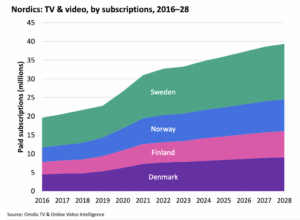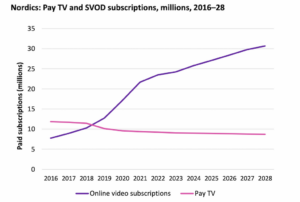TBI Tech & Analysis: Where Nordic TV trends are going next
The Nordic quartet of Denmark, Norway, Sweden and Finland have for decades tended to be forerunners when it comes to consumption trends of video content. Omdia’s Tony Gunnarsson talks TBI through what we can expect next.
Sweden, Finland, Norway and Denmark were home to 34 million subscriptions across streaming and pay TV in 2023, according to research powerhouse Omdia.
That figure is expected to rise to more than 39 million by 2028, with streaming the clear winner – yet there is a more nuanced transformation at play across the region.
Broadcast TV in the Nordics
All four Nordic markets have strong public broadcasters that are non-commercial. They have all replaced a licence-fee funding system
with public service taxes, most recently with Norway in 2019.
Nordic broadcasters are in a strong position to retain popularity despite declines in TV advertising revenue. Broadcasters’ existing relationships with big-brand advertisers and local agencies mean that they will remain central to ad-based monetisation of content for the foreseeable future.
There has been some concentration in commercial TV and pay TV: Telia owns TV4 in Sweden and MTV in Finland, for example, while in Norway, TV2, owned by the Egmont Group, has become a leading player in pay TV as well as FTA.
The current market leaders for pay TV – and by extension, the existing Nordic virtual or online pay-TV services such as Viaplay – are crucially dependent on key sports rights to retain existing subscriptions.
Similarly, Warner Bros. Discovery remains a significant player in sports: it owns the rights to the Danish and Swedish football leagues as well as the Olympics through to 2032. It will cede rights to the Danish league to TV2 from 2024.
While TV advertising revenue is in secular decline in the Nordics (driven by a strong shift of TV viewing toward streaming), it is exaggerated by a relatively weak broadcaster VOD advertising segment, which is due to broadcasters historically prioritising subscription models over advertising for online video monetization.
Added to this, the region has a weak macroeconomic environment, which is widely expected to improve after 2024. Omdia anticipates TV advertising revenue to be in overall decline through 2028.
Pay TV & streaming in the Nordics
The Nordics remain a particularly mature market for TV and video, and all signs post-COVID suggest stability in Nordic TV buying and viewing habits.
Nordic pay TV is coming out of a period of consolidation that has seen multiple key services being rebranded and remarketed. As part of this, there have been sharp declines in cable TV subscriber numbers, which has allowed IPTV to grow to become a key sector of pay TV.
For both pay TV and streaming, Omdia does not anticipate any significant change to present market shares in the foreseeable future.
For pay TV, consolidation is now in the past, and current market leaders are expected to refocus on maintaining market shares. At the
same time, the landscape for online video streaming is largely set; Omdia does not expect any significant new entrants in the SVOD
sector.
The arrival of multiple new SVOD services after 2020, including Disney+, Amazon Prime Video, and SkyShowtime, has greatly increased the market for SVOD in the Nordics, directly eating into an established market for pay TV. Streamers have also been ordering local content, such as Prime Video’s 2023 slate including a dozen unscripted shows such as Parneviks All In!.
US major services are generally dominating, but each of the four Nordic countries has typically one or two local streaming services in the top-five-ranked SVODs.
The rate of growth for SVOD is now significantly decelerating, and for the first time ever, SVOD is at single-digit annual growth rates. In turn, a multiyear contraction of pay TV is showing signs of decelerating.
As a result, Omdia does not anticipate current market shares for pay TV or SVOD to change significantly for the foreseeable future.
From 2024, most streaming services in the Nordics will shift business models from pure pay models to hybrid subscription with advertising.
The impact is likely to be a short-term uptick in streaming service subscriber numbers as customers take advantage of cheaper services, but the longer-term impact may be greater seasonality and churn for streaming services. In an uncertain Nordic TV advertising market, hybrid ad tiers are unlikely to greatly bolster SVOD revenue in the mid term.
The excerpt above is from Omdia’s Pay TV & Online Video Report: Nordics – 2024, written by principal analyst for TV, Video & Advertising, Tony Gunnarsson.
For deep-dive country-by-country breakdowns into the subject areas above, click here. Omdia, like TBI, is part of Informa Tech.






